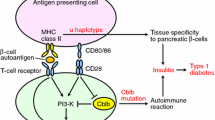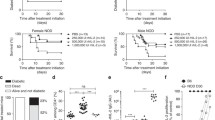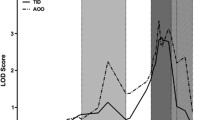Abstract
The immune response to bovine or pork insulin (BI or PI, respectively) was studied in the rat using the in vitro insulin-induced lymphocyte-proliferation assay. Results indicated that 11 inbred rat strains were divided into categories of high and low responders. Two high responders, SDJ (RT1 u) and BN(RT1 n) inbred rat strains, appeared to recognize different antigenic determinant(s) on the insulin molecule. The results of linkage and segregation analyses in F1, F2, backcross, and partially congenic rats showed that the Ir gene (Ir-BI), which encodes the high responsiveness in the SDJ rats, is inherited associated with RT1 u, whereas the immune suppression gene (Is-BI), which encodes the low responsiveness in the WKA(RT1 k) rats, is inherited together with RT1 k. The Is-BI is the first major histocompatibility complex (MHC)-linked Is gene reported in the rat. The LEJ(RTI-A u B b) inbred rat strain showed a low response to BI, indicating that Ir-BI is closer to RTI-B/RTI-D region than to RTI-A.
Similar content being viewed by others
Abbreviations
- BI:
-
bovine insulin
- HEPES:
-
N-2-hydroxyethylpiperazine-N′-2-ethanesulfonic acid
- It:
-
immune response
- Is:
-
immune suppression
- MHC:
-
major histocompatibility complex
- mol. wt.:
-
molecular weight
- PI:
-
pork insulin
- sc :
-
subcutaneously
- SD:
-
standard deviation
- SI:
-
stimulation index
References
Alkan, S.: Antigen-induced proliferation assay for mouse T lymphocytes. Response to a monovalent antigen. Eur. J. Immunol. 8: 112–118, 1978
Armerding, D., Katz, D., and Benacerraf, B.: Immune response genes in inbred rats. II. Segregation studies of the GT and GA genes and their linkage to the major histocompatibility locus. Immunogenetics 1: 340–351, 1974
Barcinski, M. and Rosenthal, A.: Immune response gene control of determinant selection. I. Intramolecular mapping of the immunogenic sites on insulin recognized by guinea pig T and B cells. J. Exp. Med. 145: 726–742, 1977
Berzofsky, J.: Genetic control of the immune response to mammalian myoglobins in mice. I. More than one I-region gene in H-2 controls the antibody response J. Immunol. 120: 360–369, 1978
Berzofsky, J. A., Schechter, A. N., Shearer, G. M., and Sachs, D. H.: Genetic control of the immune response to staphylococcal nuclease. IV. H-2-linked control of the relative proportions of antibodies produced to different determinants of native nuclease. J. Exp. Med. 145: 123–134, 1977
Berzofsky, J., Richman, L., and Killion, D.: Distinct H-2-linked Ir genes control both antibody and T cell responses to different determinants on the same antigen, myoglobin. Proc. Natl. Acad. Sci. U.S.A. 76: 4046–4050, 1979
Cohen, I. and Talman, J.: H-2 genetic control of the response of T lymphocytes to insulins. Priming of antigenic determinants. Eur. J. Immunol. 10: 284–289, 1980
Colle, E., Guttman, R., and Seemayer, T.: Spontaneous diabetes mellitus syndrome in the rat. I. Association with the major histocompatibility complex. J. Exp. Med. 154: 1237–1242, 1981
Debre, P., Kapp, J., and Benacerraf, B.: Genetic control of specific immune suppression. I. Experimental conditions for the stimulation of suppressor cells by the copolymer L-glutamic acids50-L-tyrosine50(GT) in nonresponder BALB/c mice. J. Exp. Med. 142: 1436–1446, 1975a
Debre, P., Kapp, J., Dorf, M., and Benacerraf, B.: Genetic control of specific immune suppression. II. H-2-linked dominant genetic control of immune suppression by the random copolymer L-glutamic acid50-L-tyrosines50(GT). J. Exp. Med. 142: 1447–1453, 1975b
Dorf, M., Balner, H., and Benacerraf, B.: Mapping of the immune response genes in the major histocompatibility complex of the rhesus monkey. J. Exp. Med. 142: 673–693, 1975
Ellman, L., Green, I., Martin, W., and Benacerraf, B.: Linkage between the poly-L-lysine gene and the locus controlling the major histocompatibility antigens in strain 2 guinea pigs. Proc. Natl. Acad. Sci. U.S.A. 66: 322–328, 1970
Günther, E. and Stark, O.: The major histocompatibility system of the rat. In D. Götze (ed.): The Major Histocompatibility System in Man and Animals, pp. 207–253, Springer-Verlag, New York, 1977
Günther, E., Rude, E., and Stark, O.: Antibody response in rats to the synthetic polypeptide (T, G)-A-L genetically linked to the major histocompatibility system. Eur. J. Immunol. 2: 151–155, 1972
Keck, K.: Ir-gene control of immunogenicity of insulin and A-chain loop as a carrier determinant. Nature 254: 78–79, 1975a
Keck, K.: Ir gene control of carrier recognition I. Immunogenicity of bovine insulin derivatives. Eur. J. Immunol. 5: 801–807, 1975b
Lobel, S., Shonnard, J., Miller, J., and Cramer, D.: Studies on the immune response to bovine insulin in inbred and wild rats. Transplant Proc. 13: 1394–1396, 1981
McDevitt, H. and Chinitz, A.: Genetic control of the antibody response: relationship between immune response and histocompatibility (H-2) type. Science 163: 1207–1208, 1969
McDevitt, H., Deak, B., Shreffler, D., Klein, J., Stimpfling, J., and Snell, G.: Genetic control of the immune response. Mapping of the Ir-1 locus. J. Exp. Med. 135: 1259–1277, 1972
Natori, T., Kanda, M., Ohhashi, T., Iwabuchi, K., Komuro, K., and Aizawa, M.: An estimate of the gene sequence in the major histocompatibility complex of the rat: RT1. Transplant. Proc. 13: 1568–1570, 1979
Natori, T., Iwabuchi, K., Ohhashi, T., Inomata, T., Nakagawa, H., and Aizawa, M.: Phenotypes for the RTt subregions in the Japanese inbred strains of rats. Transplant. Proc. 13: 1333–1338, 1981
Nishimura, Y. and Sasazuki, T.: An HLA-linked dominant gene controls the low responsiveness to the streptococcal antigen via suppressor T cell in man. Nature 302: 67–69, 1983
Reske-Kunz, A. and Rude, E.: Fine specificity of a T cell line reactive to bovine insulin. J. Immunol. 128: 1252–1255, 1982
Rosenwasser, L., Barcinski, M., Schwartz, R., and Rosenthal, A.: Immune response gene control of determinant selection. II. Genetic control of the murine T lymphocyte proliferative response to insulin. J. Immunol. 123: 471–476, 1979
Sasazuki, T., Kaneoka, H., Nishimura, Y., Kaneoka, R., Hayama, M., and Ohkumi, H.: An HKA-linked immune suppression gene in man. J. Exp. Med. 152: 297–313, 1980
Schroer, J., Inman, J., Thomas, J., and Rosenthal, A.: H-2-linked Ir gene control of antibody responses to insulin. I. Anti-insulin plaque-forming cell primary responses. J. Immunol. 123: 670–675, 1979
Author information
Authors and Affiliations
Rights and permissions
About this article
Cite this article
Inomata, T., Natori, T., Fujimoto, Y. et al. RT1-Linked Ir and Is genes control the immune response to bovine insulin in the rat. Immunogenetics 18, 373–385 (1983). https://doi.org/10.1007/BF00372470
Received:
Revised:
Issue Date:
DOI: https://doi.org/10.1007/BF00372470




